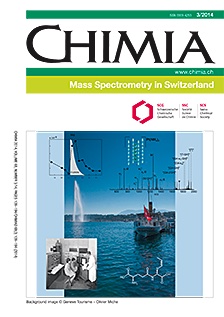Conquering the Outdoors with On-site Mass Spectrometry
DOI:
https://doi.org/10.2533/chimia.2014.155Keywords:
Environmental monitoring, Groundwater, Lakes, Membrane inlet mass spectrometry, Noble gasesAbstract
In recent years, mass spectrometers with a membrane inlet separating gases from water for final analysis have been used successfully for the on-site quantification of dissolved gases in surface waters. In 'classical' membrane inlet mass spectrometers (MIMS), the membrane directly separates the water from the high-vacuum environment of the mass spectrometer. The gas equilibrium MIMS (GE-MIMS) that is described in this review, however, makes use of an intermediate pressure reduction stage after the membrane inlet. Hence, the gas concentrations after the membrane are at steady state, near solubility equilibrium with the water to be analyzed. This setup has several advantages over classical MIMS, which enable autonomous and continuous in-field operation. The GE-MIMS can be used to acquire noble gas concentration time series (NGTS). Noble gases are useful tracers for physical gas exchange and transport in groundwater and other aqueous systems. Hence NGTS enable the temporal dynamics of physical gas exchange and transport in groundwater and other aqueous systems to be investigated. To determine the O2 turnover that has occurred in groundwater since recharge, both the O2 concentration in situ and the total input of O2 to the groundwater since recharge is needed. Determination of the latter is only possible if the relevant physical exchange and transport mechanisms can be quantified. In particular, gas exchange between soil air and groundwater often significantly affects groundwater O2 concentrations. Determination of O2 turnover in groundwater therefore requires a combined analysis of O2 and noble gas concentrations.Downloads
Published
2014-03-26
Issue
Section
Scientific Articles
License
Copyright (c) 2014 Swiss Chemical Society

This work is licensed under a Creative Commons Attribution-NonCommercial 4.0 International License.
How to Cite
[1]
L. Mächler, M. S. Brennwald, L. Tyroller, D. M. Livingstone, R. Kipfer, Chimia 2014, 68, 155, DOI: 10.2533/chimia.2014.155.







